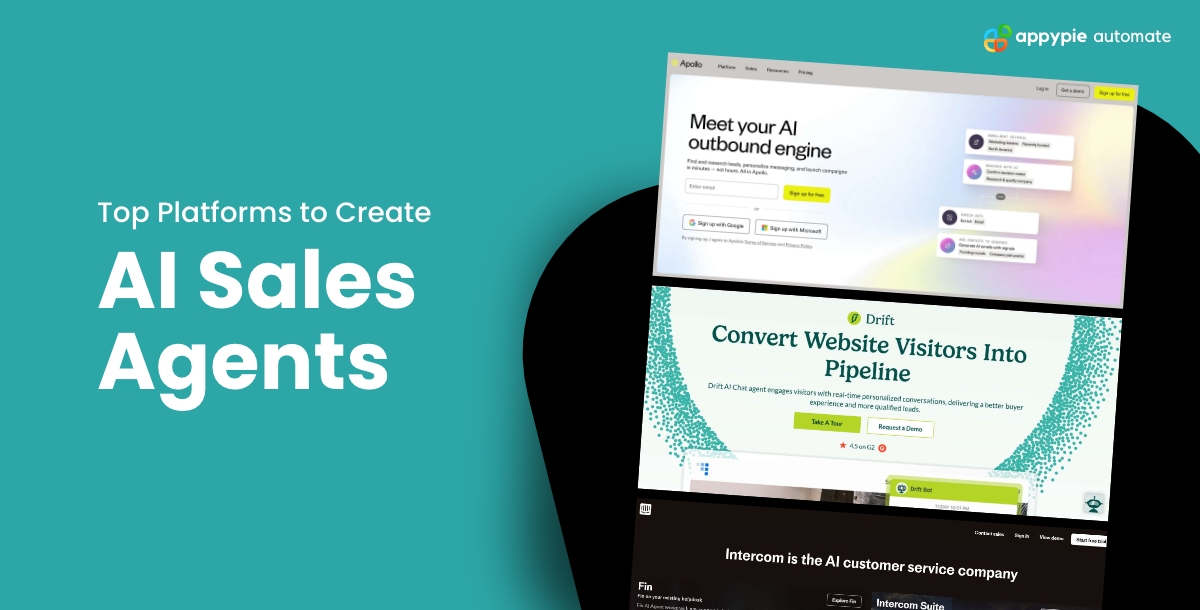Table of Contents
- What are AI Sales Agents?
- What are the key benefits and use cases of AI sales agents?
- Which platforms are the top choices for building and deploying AI sales agents?
- What is Appy Pie Agents and how does it help in sales?
- What is Drift and how does it support sales teams?
- How does Apollo.io function as an AI sales agent?
- What is HubSpot and how does it enhance sales processes?
- How does Zoho SalesIQ act as an AI sales agent?
- How does Intercom function as a sales chatbot and agent?
- What is Conversica and how does it serve as an AI sales agent?
- How do these AI sales agents compare across use cases and capabilities?
- Which AI sales agent should you choose in 2025?
- Frequently Asked Questions about AI Agents for Sales
What are AI Sales Agents?
AI sales agents are intelligent assistants that automate lead capture, qualify prospects, and handle routine conversations so sales agents can focus on closing deals. They analyze intent, personalize outreach, and keep pipelines warm across channels. Beyond a typical sales chatbot or sales bot, these systems act like proactive teammates, guiding buyers, booking meetings, and syncing with CRMs. As organizations scale globally, an AI sales agents reduce costs, shorten cycles, and elevate customer experiences across the entire revenue engine.
Unlike simple scripts, today’s AI agents combine conversational understanding with workflow logic and data connectivity. They can score leads, route conversations, and surface next-best actions to human reps. Teams deploy them on websites, messaging apps, and email to maintain 24/7 responsiveness. Companies adopting an AI sales chatbot or agent builder typically report faster response times, consistent qualification, and better meeting rates. For teams evaluating the best no-code AI agent builders, this guide maps capabilities to real sales motions.
What are the key benefits and use cases of AI sales agents?
The biggest benefits are always-on engagement, improved qualification, and time savings for human sales agents. Common use cases include answering product questions, guiding evaluations, booking demos, and reviving stalled opportunities. An AI sales chatbot can support onboarding, renewals, and cross-sell flows. When paired with analytics, an AI sales agent highlights buyer intent signals. Together, these capabilities create predictable, scalable touchpoints without sacrificing personalization, making revenue teams more resilient and efficient globally.
Organizations in SaaS, e-commerce, finance, real estate, and automotive deploy an AI agent builder to design tailored flows for acquisition and expansion. A sales chatbot mitigates handoff gaps between marketing and sales, while a sales bot keeps follow-ups on schedule. When teams anchor data in a CRM, the assistant can update records, trigger sequences, and keep managers informed. Over months, standardized automation reduces leakage, tightens forecasting, and frees reps for higher-value collaboration—these are the key advantages of AI chatbots.
Which platforms are the top choices for building and deploying AI sales agents?
Seven widely adopted platforms stand out for capability, reliability, and breadth: Appy Pie Agents, Drift, Apollo.io, HubSpot, Zoho SalesIQ, Intercom, and Conversica. Each supports different motions—conversational engagement, outbound intelligence, or follow-up automation. Selecting the right AI chatbot builder or agent builder depends on your stack, budget, and sales motion. Below, we cover what each tool does, who it’s best for, and the trade-offs to expect when implementing at scale.
To keep this practical, we begin with Appy Pie Agents for its accessibility and no-code approach, then progress through conversation-led, CRM-led, and enterprise follow-up specialists. Throughout, we note where a sales chatbot excels, where an AI sales bot might require configuration, and how integrations affect day-to-day use. We also reference patterns visible among the best AI agent frameworks in 2025 to inform architecture choices while you evaluate vendors and rollout plans.
Here’s a closer look at the top contenders:
- Appy Pie Agents — for no-code AI agent building, customizable workflows, and affordable automation at scale.
- Drift — for real-time conversational marketing, instant lead qualification, and B2B pipeline acceleration.
- Apollo.io — for outbound prospecting, sales intelligence, and automated engagement sequences.
- HubSpotf — for CRM-integrated AI, predictive lead scoring, and simplified chatbot building.
- Zoho SalesIQ — for AI-driven live chat, visitor tracking, and SMB-friendly customer engagement.
- Intercom — for multichannel messaging, guided customer journeys, and product-led sales motions.
- Conversica — for enterprise-scale follow-up, human-like AI outreach, and persistent multichannel engagement.
What is Appy Pie Agents and how does it help in sales?

Appy Pie Agents is a no-code AI agent builder that lets teams design customized AI sales agents for lead capture, qualification, and guided conversions. It streamlines setup so non-technical users can launch a sales chatbot quickly, connect to CRMs, and route opportunities to human reps. With reusable workflows and global accessibility, organizations scale an AI sales bot to handle repetitive conversations, maintain fast responses, and improve consistency—without heavy engineering or complex maintenance overhead.
Built for accessibility, Appy Pie Agents helps businesses deploy sales agents across websites, landing pages, and messaging channels. Visual workflow tools make it straightforward to craft branching logic, FAQs, and demo-booking paths. It integrates with popular CRMs and automation ecosystems so records stay current and outreach remains coordinated. Teams can iterate quickly, test prompts, and adapt flows for different segments or regions. This balance of speed, control, and affordability makes it attractive to startups and growing global brands.
Pros
- No-code setup; fast time to value for an AI sales agent.
- Customizable workflows for varied industries and regions.
- Integrations with CRMs and marketing automation tools.
- Scales from simple sales chatbot use cases to richer flows.
Cons
- Advanced logic may require careful design and testing.
- Deeper analytics often rely on connected BI/CRM reporting.
What is Drift and how does it support sales teams?

Drift is a conversational platform known for real-time engagement and meeting acceleration. Its AI sales agents greet visitors, qualify prospects, and book appointments directly from chat. Behavioral targeting personalizes outreach, while CRM integrations hand off context to reps. Drift excels in B2B scenarios where a sales chatbot must identify intent quickly and connect buyers with humans. Teams use it to reduce friction, compress time-to-meeting, and keep pipeline creation predictable on high-traffic pages.
Drift popularized conversational marketing by turning website traffic into scheduled conversations. Its playbooks let teams tailor prompts by account, segment, or intent signals. The assistant can handle FAQs, route based on territory, and escalate to humans via live chat. With strong Salesforce and marketing stack integrations, ops teams maintain clean data and attribution. While feature-rich, it can feel complex; plan enablement and governance carefully to avoid playbook sprawl—this illustrates practical ways chatbots increase sales at scale.
Pros
- Real-time engagement and demo booking from chat.
- Behavioral targeting and personalized experiences.
- Mature CRM and MAP integrations for B2B teams.
- Robust playbooks for complex qualification rules.
Cons
- Can be expensive for smaller teams.
- Requires governance to prevent playbook sprawl.
How does Apollo.io function as an AI sales agent?
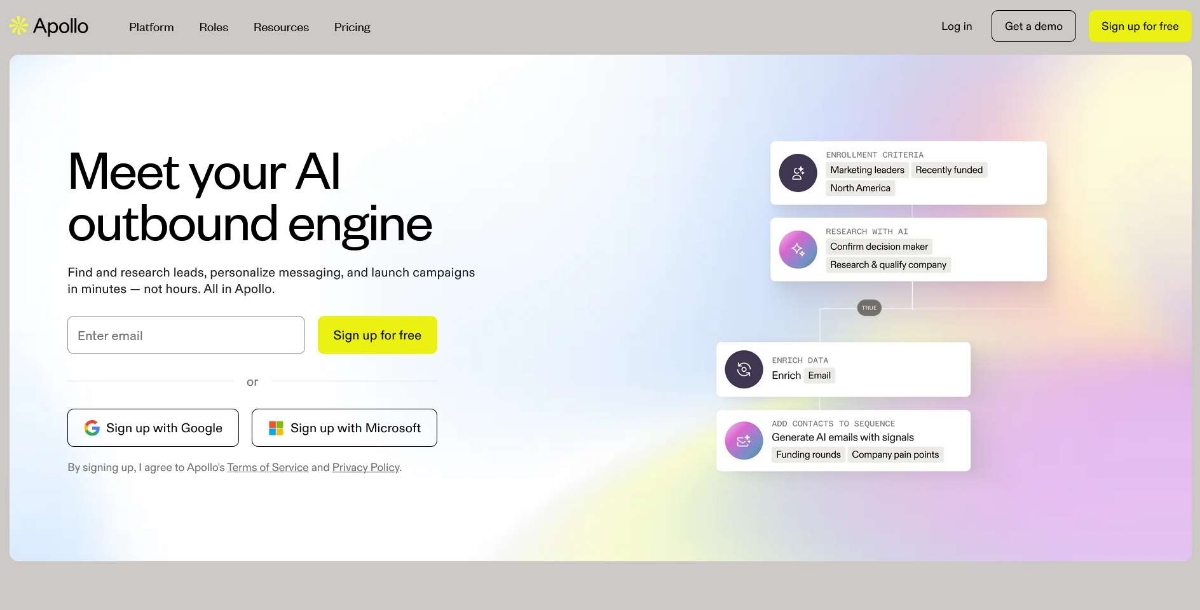
Apollo.io blends a vast prospect database with automation to power outbound motions. While not a classic sales chatbot, its AI sales agents features include intent discovery, sequence optimization, and structured outreach. Teams enrich accounts, prioritize targets, and scale personalized campaigns. When combined with an agent builder or chat assistant on-site, Apollo.io strengthens the top of funnel: it finds, filters, and fuels conversations that downstream bots or human sales agents convert into meetings and revenue.
Outbound success depends on targeting and timing; Apollo.io addresses both. Users build account lists, apply firmographic and technographic filters, and trigger multi-touch outreach with personalization. Engagement data feeds prioritization, allowing reps to focus on warmer leads. Its value compounds when synced tightly with your CRM so ownership, stages, and activity are consistent. Many teams pair Apollo.io with a website AI sales agent to capture inbound while outbound sequences generate net-new interest from ideal customer profiles.
Pros
- Large, filterable contact and company database.
- Sequencing, analytics, and intent-driven prioritization.
- Complements website chat and demo-booking flows.
- Strong fit for startup and SMB outbound teams.
Cons
- Not a full AI chatbot builder for onsite conversations.
- Data accuracy varies; requires list hygiene and testing.
What is HubSpot and how does it enhance sales processes?
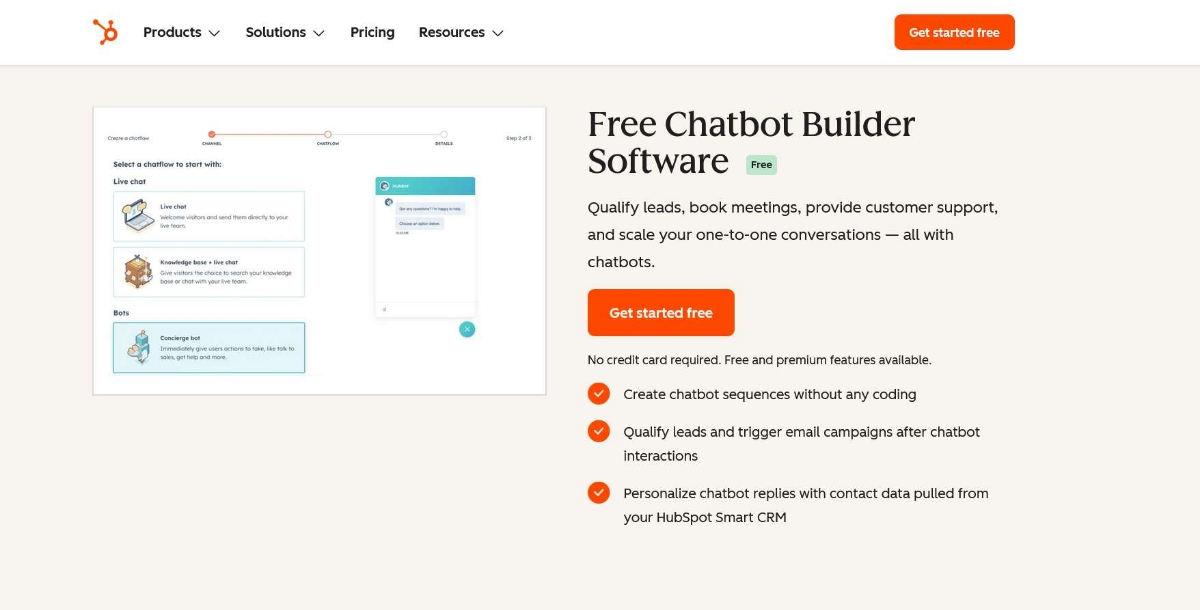
HubSpot embeds AI conversational tools, scoring, and forecasting inside a familiar CRM. Teams spin up an AI sales chatbot for lead capture, score prospects with predictive models, and orchestrate automated follow-ups. Because data, messaging, and reporting live together, sales agents maintain continuity across the funnel. For organizations already on HubSpot, these AI sales agents reduce tool sprawl, speed handoffs, and create cleaner attribution—supporting smarter prioritization and more consistent revenue execution.
HubSpot’s advantage is end-to-end alignment. Marketing forms and chat feed records with enriched context; playbooks nudge reps to next steps; sequences keep outreach timely. Managers gain visibility into conversion points without stitching dashboards across vendors. The built-in chatbot builder is approachable for no-code users, while advanced teams can extend flows with apps and custom objects. Plan governance, lifecycle definitions, and routing early so automation mirrors your sales process and avoids duplicate work for human reps.
Pros
- Native to a widely adopted CRM platform.
- Predictive scores, sequences, and playbooks.
- Approachable chatbot builder for no-code users.
- Unified data improves reporting and handoffs.
Cons
- Advanced capabilities may require higher tiers.
- Complex orgs need careful lifecycle governance.
How does Zoho SalesIQ act as an AI sales agent?

Zoho SalesIQ combines live chat with an AI sales chatbot to engage visitors, score leads, and connect to the Zoho ecosystem. It’s compelling for teams standardizing on Zoho CRM who need efficient routing and responsive support. An AI sales bot can greet prospects, answer product questions, and escalate to humans. For SMBs and cost-sensitive teams, SalesIQ offers dependable capabilities that balance automation with live assistance inside an integrated, globally accessible platform.
SalesIQ’s strength is unifying real-time chat with bot automation and analytics. Businesses configure proactive triggers, tailor FAQs, and leverage behavior insights to prioritize outreach. Tight integration with Zoho CRM keeps ownership and opportunity data clean. While it’s not the most advanced agent builder, it covers common needs like demo scheduling, resource sharing, and lead capture effectively. For many small and mid-sized companies, this blend of affordability, simplicity, and integration makes SalesIQ a pragmatic choice.
Pros
- Good blend of live chat and automation.
- Integrated with Zoho CRM and apps.
- Approachable for small and midsize teams.
- Global, budget-friendly footprint.
Cons
- Less depth than specialized enterprise tools.
- Customization ceilings for complex workflows.
How does Intercom function as a sales chatbot and agent?
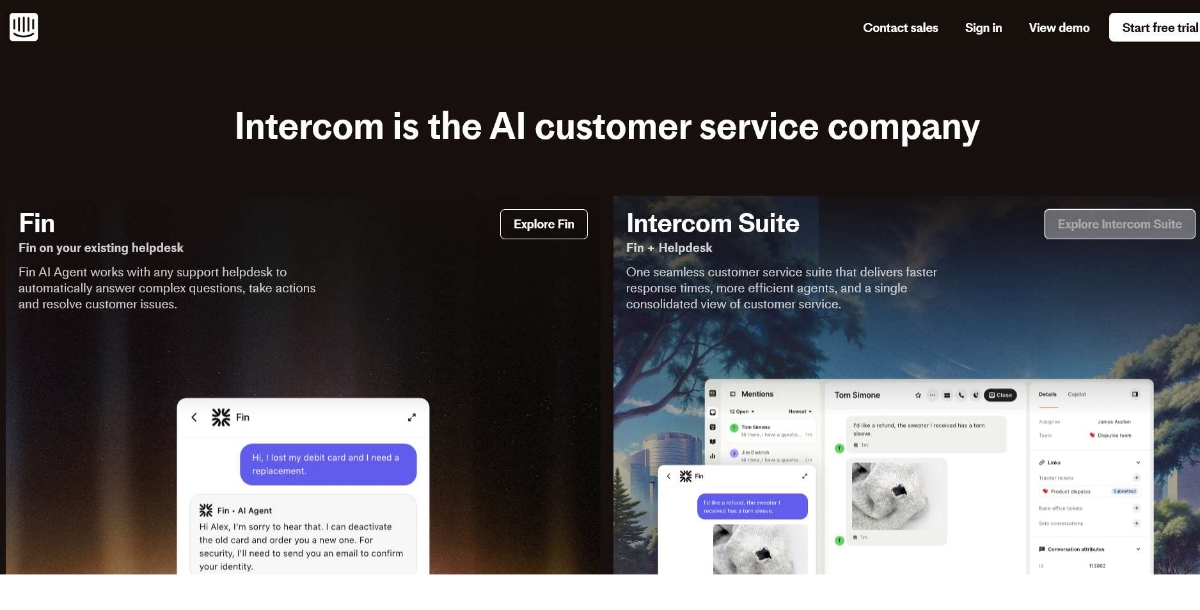
Intercom blends an AI sales chatbot with inbox, automation, and proactive messaging. Its agent builder creates branched journeys that qualify visitors, book meetings, and hand off context to humans. With multichannel support and app integrations, Intercom scales personalized engagement across the lifecycle. Companies choose it when they need elegant experiences that unify product, marketing, and sales conversations—keeping sales agents focused while buyers receive timely, relevant assistance throughout evaluation.
Intercom is strong in product-led and self-serve motions where in-app experiences matter. Teams create guided paths, use banners or tooltips, and trigger bot conversations at key moments. The platform’s extensibility supports data-driven routing and tailored replies. Ops should define ownership rules and knowledge bases early so answers remain accurate at scale. For organizations that prize cohesive UX across web and product, Intercom’s balance of automation and human touch is a durable differentiator.
Pros
- Refined UX across web and in-app channels.
- Flexible journeys with strong app ecosystem.
- Great fit for product-led growth motions.
- Keeps humans in the loop elegantly.
Cons
- Costs can rise with scale and seat needs.
- Advanced orchestration requires careful design.
What is Conversica and how does it serve as an AI sales agent?
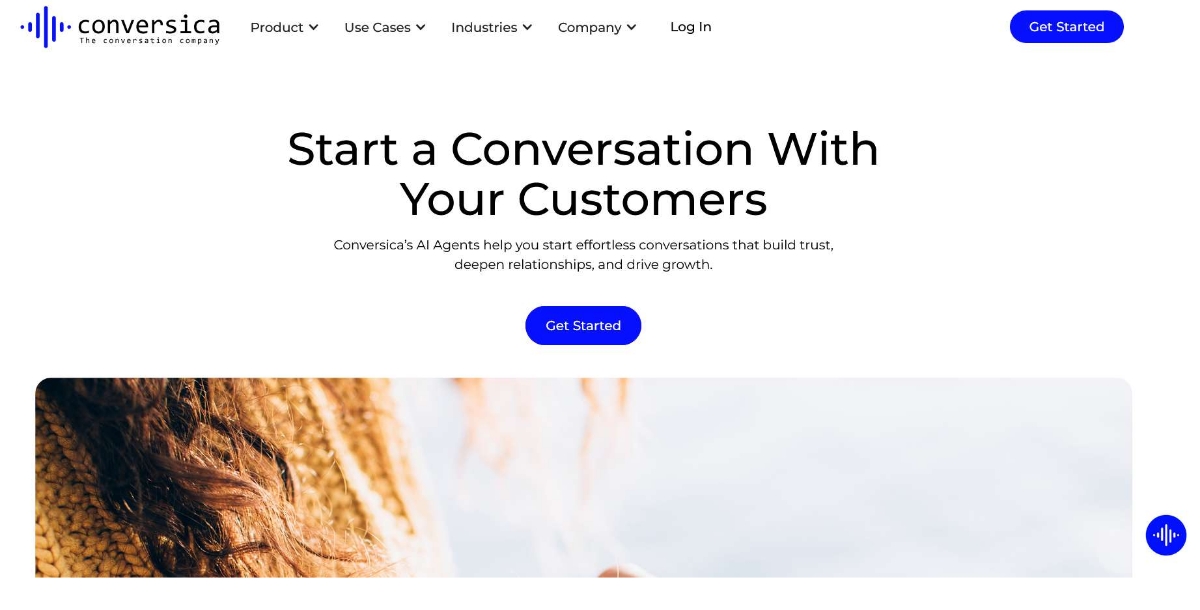
Conversica is known for lifelike follow-up at enterprise scale. Its AI sales agents run persistent, multi-channel outreach—email, chat, SMS—to revive leads, nurture interest, and drive meetings. Messages feel human, with context awareness across threads. Large databases benefit most: the assistant re-engages quiet accounts while reps focus on active deals. As a specialized sales agent platform, Conversica helps organizations ensure no inquiry or hand-raiser slips through the cracks.
Enterprises deploy Conversica to operationalize consistent, courteous persistence. Templates adapt to products, regions, and lifecycle moments, while analytics quantify replies and conversions. Ops teams align rules with territories and SLAs so qualified responses route fast. Because messaging resembles human tone, buyers remain receptive longer. Plan integration with CRM and MAP carefully to avoid duplicates and preserve attribution. When volumes are high and pipelines broad, Conversica’s follow-through becomes a compounding competitive advantage.
Pros
- Human-like tone across channels at scale.
- Excellent for reviving and nurturing large databases.
- Clear analytics for reply and conversion tracking.
- Reduces manual follow-up burden on reps.
Cons
- Typically aligned to enterprise budgets and needs.
- Requires thoughtful mapping to CRM/MAP to avoid conflicts.
How do these AI sales agents compare across use cases and capabilities?
All seven platforms deliver measurable gains, but each emphasizes different strengths. If you need a no-code AI agent builder, start with Appy Pie Agents. For real-time B2B chat, Drift excels. Apollo.io powers outbound intelligence, while HubSpot AI centralizes automation inside the CRM. Zoho SalesIQ suits integrated, budget-friendly stacks. Intercom shines in product-led journeys. Conversica dominates large-scale follow-up. Use the table below to align core needs with the right sales agent for your motion.
| Tool | Best For | Key Features | Pros | Cons |
|---|---|---|---|---|
| Appy Pie Agents | No-code builds; fast launch across regions | Visual agent builder, CRM connectors, reusable flows | Accessible, scalable, affordable, global reach | Advanced logic needs careful testing; relies on connected analytics |
| Drift | B2B real-time demos and routing | Playbooks, behavioral targeting, live handoffs | Excellent chat UX; strong Salesforce alignment | Costly for small teams; governance required |
| Apollo.io | Outbound prospecting and sequences | Database, enrichment, engagement analytics | Great targeting; complements chat assistants | Not an onsite AI sales chatbot builder |
| HubSpot AI | CRM-first automation and alignment | Chatbot, scoring, forecasting, sequences | Unified data; approachable builder | Advanced features on higher tiers |
| Zoho SalesIQ | Integrated Zoho stacks, SMB value | Live chat + bot, visitor insights, routing | Budget-friendly; ecosystem cohesion | Customization ceilings for complex orgs |
| Intercom | Product-led and in-app journeys | Journeys, inbox, proactive messaging | Refined UX; robust ecosystem | Costs can rise; design discipline needed |
| Conversica | Enterprise follow-up at scale | Email, chat, SMS persistence; analytics | Lifelike tone; revives dormant pipeline | Enterprise-oriented cost and setup |
Which AI sales agent should you choose in 2025?
AI sales agents are no longer optional add-ons—they’re becoming the backbone of modern revenue operations. From Appy Pie Agents enabling no-code customization and affordability, to Drift accelerating real-time B2B engagement, each platform brings unique strengths to the table. Apollo.io powers outbound prospecting with intelligent targeting, while HubSpot AI integrates seamlessly into CRM workflows for unified execution. Zoho SalesIQ makes automation accessible to SMBs, Intercom elevates product-led and multichannel experiences, and Conversica ensures enterprise-scale persistence with human-like follow-up.
The right choice depends on your motion, budget, and maturity. Whether you need lightweight automation, CRM-first orchestration, or enterprise-grade outreach, these seven AI sales agents represent the leading edge of sales technology in 2025. By adopting and scaling the right tool, businesses can shorten cycles, boost engagement, and unlock sustainable growth in an increasingly competitive landscape.
Frequently Asked Questions about AI Agents for Sales
What is the difference between an AI sales agent and a sales chatbot?
An AI sales agent manages multi-step processes like scoring, routing, and meeting creation, while a sales chatbot primarily answers questions and gathers context. Agents bridge marketing and sales by updating systems, triggering actions, and escalating to humans. A sales bot is the conversational surface; the agent coordinates the work behind it. Used together, they deliver instant replies, consistent qualification, and reliable handoffs that keep opportunities moving through your pipeline.
How should small teams prioritize their first AI sales agent use case?
Start with one high-leverage flow: capturing inbound questions and booking demos. Launch a focused AI sales chatbot to answer top FAQs, qualify with two or three criteria, and route meetings to the right rep. Keep copy concise, integrate your CRM, and track conversion. Expand into nurture and renewals later. By proving value quickly, small teams build confidence, refine prompts, and earn support to scale an AI sales agent across more journeys.
What criteria matter most when choosing an agent builder?
Prioritize usability, integrations, and governance. Your AI agent builder should let non-technical users design flows, connect to the CRM and marketing stack, and manage versions safely. Ensure analytics cover conversations, qualification, and booked meetings. Confirm support for multilingual experiences if you sell globally. Finally, align pricing and rollout with your maturity—expensive features only help if they’re adopted, measured, and maintained by your revenue operations and enablement teams.
Will AI sales agents replace human sales agents?
No—automation augments people. An AI sales agent handles repetitive steps so humans focus on discovery, consensus building, and negotiation. Buyers still value expertise and trust, especially for complex deals. The ideal model pairs a responsive sales chatbot with reps who add context, creativity, and empathy. This hybrid raises win rates, makes teams more productive, and improves buyer experiences without increasing headcount at the same pace as growth.
Which industries gain the most from AI sales agents?
SaaS, e-commerce, financial services, real estate, and automotive benefit significantly due to high lead volume and multi-touch journeys. A sales agent assists across research, trial, and purchase steps, while an AI sales chatbot clarifies pricing, integrations, or availability on demand. Regulated fields value audit trails and consistent messaging. When localization matters, choose tools that support multilingual content so regional teams deliver relevant experiences with minimal operational friction.
Related Articles
- 7 Best Platforms to Create AI Receptionists
- How to Chat with Gmail Using MCP Agent?
- Best Generative AI Agents in 2025: The Tools Leading Autonomous Intelligence
- How to Use Computer Use Agents for Performing Tasks?
- How to create an AI voice agent?
- What Are AI Voice Agents?
- Best AI Agent Frameworks in 2025: The Ultimate Guide to Building Autonomous AI Agents
- 10 Best Computer Use Agents in 2025
- 11 Best Chatbot Software for Enterprise Businesses
- What Are Computer Use Agents (CUAs)?
- 7 Best Platforms to Create AI Travel Agents
- 50 AI Agents Examples Transforming Industries in 2025
- Best No-Code AI Agent Builders in 2025
- 7 Best Platforms to Create AI Recruiters
- What Are AI Agents? Types, Examples, and How to Build with No-Code
